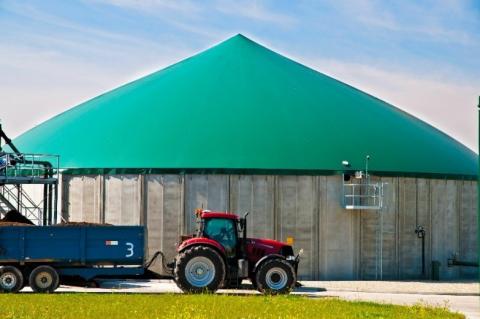Dr Natalie Meades: IBERS, Aberystwyth University.
- The use of renewable heat energy on farm provides an alternative to fossil fuels, helping to reduce on farm emissions, carbon footprints improve sustainability.
- The use of renewable heat on farm provides the opportunity to lower energy bills through reduced reliance on the national grid.
- The incentive to adopt renewable heat energy may increase through greater support, funding and grants.
Introduction
The use of renewable energy on farm as described in a previous technical article can provide a way for farms to become more diversified, reduce environmental emissions, reduce energy costs and become more sustainable. Not only that, renewable energies provide rural farms that are not connected to the grid with more energy options and choices. Renewable energies can be used to generate electricity and/ or heat depending on the technology. This article will focus on renewable energy and heat.
Heat produced from renewable energies can be used on farm for a variety of purposes such as; heating farm buildings and holiday cottages, drying grain and crops, maintaining temperatures within storage sheds and glasshouses and for heating water to name a few. The dairy and poultry industries are reliant on generating heat for their day to day running. In the dairy industry, heating water is thought to be the second largest consumer of electricity following milk cooling accounting for 25 – 35 % of total energy costs. In such systems, water is heated to different temperatures for different activities, for example, water is heated up to 85oC for cleaning, up to 65oC for tank washing, up to 40oC for calf milk preparations and between 40-50oC for hand washing. The poultry industry also uses a high amount of energy for heating to maintain sheds at temperatures conducive for production. In fact, the average standard broiler house consumes approximately 240-270 megawatts hours of heat energy per year. At certain times of the year the arable, horticulture and potato sectors are reliant on producing heat to dry grain for storage, to maintain temperatures in glasshouses for optimal plant growth and to maintain the temperature of sheds for the storage of produce.
The UK Government introduced a financial incentive scheme known as the non-domestic renewable heat incentive which gave payments to businesses, the public sector and non-profit organisations in Wales, Scotland and England for the amount of heat energy generated from renewable technologies such as; biomass, heat pumps, deep geothermal, solar thermal, combined heat and power, biomethane and biogas. Likewise, payments were also given to residencies as part of the domestic renewable heat incentive for homes heated by renewable technologies such as; biomass boilers, solar water heating and for certain heat pumps. As such, the payments provided by these schemes helped with return on investment and in some cases provided revenue opportunities. However, these schemes are all closed to new applicants. Nevertheless, although funding for renewable heat technologies is limited, the reduction of energy bills and reduction in environmental emissions make renewable heat an appealing option.
What technologies are available for use on farm?
Solar Thermal
Solar thermal works by converting solar radiation into thermal energy that can be utilised to heat water, heat buildings and to dry. As such, this differs to solar photovoltaic technology which converts solar energy into electricity.
Solar water heating systems are a popular renewable energy technology used to heat water and provide heating. Before installation like with most renewable heat technologies, the plumbing of the building should be taken into consideration and if the current water system can be connected or if investment into a new system is required. The technology consists of panels or tubes that can be situated on the rooftops of agricultural buildings and sheds as well as in the field, although the latter is less common due to panels needing to be in close proximity to hot water systems. Water within panels contains an antifreeze solution that is heated by the sun during the day. This heated solution then passes through a heat exchanger providing hot water to buildings. Solar thermal is dependent on the weather, as such the positioning of panels for maximum solar exposure is key. However, in the winter months when temperatures are low and the days are short, it is unlikely that solar thermal on its own can provide sufficient heat for demand, therefore a backup system is often recommended.
Ground Source Heat Pumps
Ground source heat pumps otherwise known as geothermal heat pumps, work by converting solar energy that is stored within the ground into heat. Through specialist equipment this heat can then be used to heat buildings or heat water. Other types of heat pumps also exist, such as those that convert air and water into heat. Conversely heat pumps can remove hot air from buildings and transfer it back to the ground helping to passively cool buildings.
Ground source heat pumps are extremely attractive regarding their low operational costs and low maintenance requirements. Furthermore, a study in Korea demonstrated the use of ground source heat pumps in broiler sheds to create a better living environment for birds in terms of air quality, where sheds heated by ground source heat pumps had less carbon dioxide and ammonia in the air compared to conventional sheds. Furthermore, bird final body weight gains were greater than those housed in conventional sheds which was thought to be a result of improved air quality.
Biomass
Biomass consists of organic matter derived from plants, animals, fungi or algae. Plant biomass can be used as a substrate for generating renewable energy. There are different types of technologies available with systems selected largely dependent on energy demand and type. Through the processes of gasification and pyrolysis, plant biomass can be intensively heated in the absence or partial absence of oxygen to generate syngas (hydrogen, carbon monoxide, carbon dioxide, methane), which can then be used to generate electricity and heat. Alternatively, plant biomass can undergo combustion which involves the burning of biomass in the presence of oxygen which generates heat. It is generally accepted that when biomass is burnt, the carbon emitted is equal to the carbon taken up by plants during growth and therefore does not accumulate in the atmosphere as carbon dioxide.
Biomass boilers can be installed on farm and plant biomass fed into a combustion chamber for ignition which generates heat. Heat can then be used to heat water and subsequently heat sheds, buildings or utilised for drying. The feeding of biomass into the boiler can be manual, semi-automated or fully automated depending on the technology, scale, substrate type and form (logs, wood chips, shredded, pelleted, ground).
Biomass can be bought from various commercial companies for direct use in biomass boilers. As such consideration is needed as to the availability of space for storage and fluctuations in price when buying in wood stock. However, there is opportunity to grow and process biomass crops on farm, provided they have sufficient capacity and equipment to do so. Likewise, there is also opportunity for farms to become more diversified and produce biomass crops for selling to commercial energy producers and generate additional revenue. However, many may have concern with this regarding food security and competition with the timber industry. Moreover, there may be the potential in the future for fallen trees and old rotten fence posts (depending on chemical treatment) to be utilised in biomass boilers provided they are compatible with the boiler, comply with regulations and are dry. Likewise in the future with the right machinery and technology there may be the potential for hedge trimmings to be utilised as substrate for biomass boilers. These are all good examples of recycling waste material and contributing to a circular economy.
Plant biomass in this instance consists of non-food bioenergy crops such as perennial grasses, herbaceous plants and woody crops. Examples of grasses include; miscanthus, reed canary grass, switch grass and arundo. Woody crops include short rotation crops that involve either short rotation coppice or short rotation forestry. Examples include willow, poplar, common alder, black locust, paulownia and eucalyptus. Other bioenergy crops include hemp, sida and cup plant. Bioenergy crops such as these generally have high growth rates, produce large volumes of biomass, re-sprout after multiple harvests and have low nutrient requirements and as such are easy to grow. When selecting biomass crops it is important to consider the characteristics and properties of the plants. For example, plants such as black locust are invasive species and toxic to livestock and horses. Consideration is also needed as to the ease of converting land back to agricultural practice if desired.
The integration of biomass crops on farm has demonstrated positive environmental effects. Biomass crops have the ability to capture carbon dioxide and therefore sequester carbon in the soil, which can help to improve soil health as well as mitigate the effects of climate change. Moreover, certain species such as alder have nitrogen fixing abilities. Certain biomass crops also have the potential to improve plant, animal and insect biodiversity on farm depending on the scale and design of the biomass site, plant life stage, management practices and characteristics of the surrounding environment. The incorporation of biomass crops as part of buffer strips has also been demonstrated to have positive effects on the environment by reducing the risk of flooding, soil erosion and ground water pollution.
Anaerobic Digestion
Anaerobic digestion (AD) is another biomass technology that can convert wet forms of biomass such as slurry, manure, poultry litter and food waste into heat. Microorganisms break down and ferment organic matter producing biogas and a digestate. Biogas can be used to produce heat and/ or electricity. Biogas can be further processed in which carbon dioxide is removed leaving biomethane which can be integrated into the grid as a renewable gas. Not only does AD technology have renewable energy generating benefice the digestate left over can be utilised as a fertiliser for the land, reducing reliance on other finite resources.
Waste Heat Recovery
Within certain agricultural productions heat is generated as a by-product. For example, livestock emit heat as a by-product of metabolism. In addition, animal faeces and bedding undergoing microbial degradation and fermentation generates heat. In the past this heat has been put to good use. For example, on small holdings chicken and pig housing would have traditionally been in the same building on some holdings. The chickens would have been housed on the upper level of the building above the pigs and the heat from the pigs would have helped to keep the chickens warm overnight and during the winter months when temperatures were low. Through innovation, what if we could use a similar principle and recover heat for use elsewhere. This would help to close waste loops and contribute to a circular economy. A pilot study in Poland aimed to do just that, where a tubular heat exchanger was installed on a pig farm under a deep litter bed to recover heat generated within bedding. Moreover, waste heat recovery is something that is used by the dairy industry. The cooling of milk to 4oC requires a high amount of electricity and heat is generated as a by-product of this process. Through the use of heat exchangers, heat can be recovered and used to heat water therefore reducing energy costs elsewhere on farm. Likewise, waste heat recovery systems have been utilised in greenhouses and have demonstrated improvements in improving energy efficiency.
Summary
The adoption of renewable heat technologies on farm can help to reduce reliance on fossil fuels and improve the sustainability of practices through reduced emissions. Renewable energy on farms also provides an opportunity to lower energy bills through reduced reliance on the grid. Greater support in terms of funding and grants for the initial installation of equipment and invitations to demonstration sites may increase incentive and uptake of such technologies on farms and in homes in the future and therefore help towards achieving net zero.



